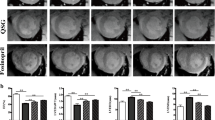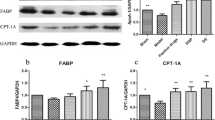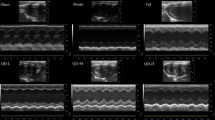Abstract
Objective
To investigate the cardioprotective effect of Danqi Tablet (DQT, 丹七片) on ischemic heart model rats and the regulative effect on energy metabolism through peroxisome proliferator-activated receptor-γ coactivator-1α (PGC-1α).
Methods
Rat ischemic heart model was induced by ligation of left anterior descending coronary artery. Totally 40 Sprague-Dawley rats were randomly divided into sham group, model group, DQT group (1.5 mg/kg daily) and trimetazidine (TMZ) group (6.3 mg/kg daily) according to a random number table, 10 rats in each group. Twenty-eight days after continuous administration, cardiac function was assessed by echocardiography and the structures of myocardial cells were observed by hematoxylin-eosin staining. The level of adenosine triphosphate (ATP) in myocardial cells was measured by ATP assay kit. Expressions level of key transcriptional regulators, including PGC-1α, Sirtuin 1 (SIRT1), AMP-activated protein kinase (AMPK), and downstream targets of PGC-1α, such as mitofusin 1 (MFN1), mitofusin 2 (MFN2) and superoxide dismutase 2 (SOD2) were measured by Western blot. Expression level of PGC-1α was examined by immunohistochemical staining.
Results
The rat ischemic heart model was successfully induced and the heart function in model group was compromised. Compared with the model group, DQT exerted cardioprotective effects, up-regulated the ATP production in myocardial cells and inhibited the infiltration of inflammatory cells in the margin area of infarction of the myocardial tissues (P<0.01). The expressions of PGC-1α, SIRT1 and AMPK were increased in the DQT group (all P<0.05). Furthermore, the downstream targets, including MFN1, MFN2 and SOD2 were up-regulated (P<0.05 or P<0.01). Compared with the TMZ group, the expression levels of PGC-1α, MFN1 and SOD2 were increased by DQT treatment (P<0.05 or P<0.01).
Conclusion
DQT regulated energy metabolism in rats with ischemic heart model through AMPK/SIRT1 -PGC-1α pathway. PGC-1α might serve as a promising target in the treatment of ischemic heart disease.
Similar content being viewed by others
References
Mozaffarian D, Benjamin EJ, Go AS, Arnett DK, Blaha MJ, Cushman M, et al. Heart disease and stroke statistics—2015 update: a report from the American Heart Association. Circulation 2015;131:e29–e322.
Austin S, St-Pierre J. PGC1α and mitochondrial metabolism-emerging concepts and relevance in ageing and neurodegenerative disorders. J Cell Sci 2012;125:4963–4971.
Hardie DG. AMP-activated/SNF1 protein kinases: conserved guardians of cellular energy. Nat Rev Mol Cell Biol 2007;8:774–785.
Winder WW, Holmes BF, Rubink DS, Jensen EB, Chen M, Holloszy JO. Activation of AMP-activated protein kinase increases mitochondrial enzymes in skeletal muscle. J Appl Physiol (1985) 2000;88:2219–2226.
Canto C, Gerhart-Hines Z, Feige JN, Lagouge M, Noriega L, Milne JC, et al. AMPK regulates energy expenditure by modulating NAD+ metabolism and SIRT1 activity. Nature 2009;458:1056–1060.
Terada S, Goto M, Kato M, Kawanaka K, Shimokawa T, Tabata I. Effects of low-intensity prolonged exercise on PGC-1 mRNA expression in rat epitrochlearis muscle. Biochem Biophys Res Commun 2002;296:350–354.
Della-Morte D, Dave KR, DeFazio RA, Bao YC, Raval AP, Perez-Pinzon MA. Resveratrol pretreatment protects rat brain from cerebral ischemic damage via a sirtuin 1-uncoupling protein 2 pathway. Neuroscience 2009;159:993–1002.
Aquilano K, Vigilanza P, Baldelli S, Pagliei B, Rotilio G, Ciriolo MR. Peroxisome proliferator-activated receptor γ co-activator 1α (PGC-1α) and sirtuin 1 (SIRT1) reside in mitochondria: possible direct function in mitochondrial biogenesis. J Biol Chem 2010;285:21590–21599.
Nemoto S, Fergusson MM, Finkel T. SIRT1 functionally interacts with the metabolic regulator and transcriptional coactivator PGC-1α. J Biol Chem 2005;280:16456–16460.
Rowe GC, Jiang A, Arany Z. PGC-1 coactivators in cardiac development and disease. Circ Res 2010;107:825–838.
Gao ZY, Xu H, Shi DZ, Wen C, Liu BY. Analysis on outcome of 5284 patients with coronary artery disease: the role of integrative medicine. J Ethnopharmacol 2012;141:578–583.
Zhou L, Zuo Z, Chow MS. Danshen: an overview of its chemistry, pharmacology, pharmacokinetics, and clinical use. J Clin Pharmacol 2005;45:1345–1359.
Ng TB. Pharmacological activity of Sanchi ginseng (Panax notoginseng). J Pharm Pharmacol 2006;58:1007–1019.
Wang Y, Li C, Wang Q, Shi T, Wang J, Chen H, et al. Danqi Pill regulates lipid metabolism disorder induced by myocardial ischemia through FATP-CPTI pathway. BMC Complement Altern Med 2015;15:28.
Wang Q, Meng H, Zhang Q, Shi T, Zhang X, Shao M, et al. Multitarget effects of Danqi Pill on global gene expression changes in myocardial ischemia. Int J Genomics 2018;2018:9469670.
Cui YC, Yan L, Pan CS, Hu BH, Chang X, Fan JY, et al. The contribution of different components in QiShenYiQi Pills® to its potential to modulate energy metabolism in protection of ischemic myocardial injury. Front Physiol 2018;9:389.
Chang H, Wang Q, Shi T, Huo K, Li C, Zhang Q, et al. Effect of DanQi Pill on PPAR α, lipid disorders and arachidonic acid pathway in rat model of coronary heart disease. BMC Complement Altern Med 2016;16:103.
Zhang Q, Shao M, Zhang X, Wang Q, Guo D, Yang X, et al. The effect of Chinese medicine on lipid and glucose metabolism in acute myocardial infarction through PPARγ pathway. Front Pharmacol 2018;9:1209.
Finck BN, Kelly DP. PGC-1 coactivators: inducible regulators of energy metabolism in health and disease. J Clin Invest 2006;116:615–622.
Banke NH, Wende AR, Leone TC, O’Donnell JM, Abel ED, Kelly DP, et al. Preferential oxidation of triacylglyceride-derived fatty acids in heart is augmented by the nuclear receptor PPAR α. Circ Res 2010;107:233–241.
Imai S. The sirtuin family: regulators that connect metabolism, aging, and longevity. Clin Calcium 2013;23:29–38.
Borradaile NM, Pickering JG. NAD(+), sirtuins, and cardiovascular disease. Curr Pharm Des 2009;15:110–117.
Lopaschuk Gary D, Barr R, Thomas Panakkezhum D, Dyck Jason RB. Beneficial effects of trimetazidine in ex vivo working ischemic hearts are due to a stimulation of glucose oxidation secondary to inhibition of long-chain 3-ketoacyl coenzyme A thiolase. Circ Res 2003;93:e33–e37.
Archer SL. Mitochondrial dynamics-mitochondrial fission and fusion in human diseases. N Engl J Med 2013;369:2236–2251.
Vasquez-Trincado C, Garcia-Carvajal I, Pennanen C, Parra V, Hill JA, Rothermel BA, et al. Mitochondrial dynamics, mitophagy and cardiovascular disease. J Physiol 2016;594:509–525.
Dorn GW, 2nd. Mitochondrial dynamism and heart disease: changing shape and shaping change. EMBO Mol Med 2015;7:865–877.
Hernandez-Alvarez MI, Thabit H, Burns N, Shah S, Brema I, Hatunic M, et al. Subjects with early-onset type 2 diabetes show defective activation of the skeletal muscle PGC-1α / Mitofusin-2 regulatory pathway in response to physical activity. Diabetes Care 2010;33:645–651.
St-Pierre J, Drori S, Uldry M, Silvaggi JM, Rhee J, Jager S, et al. Suppression of reactive oxygen species and neurodegeneration by the PGC-1 transcriptional coactivators. Cell 2006;127:397–408.
Author information
Authors and Affiliations
Corresponding author
Additional information
Supported by the National Natural Science Foundation of China (No. 81503379, 81822049, and 81673712)
Rights and permissions
About this article
Cite this article
Meng, H., Wang, Qy., Li, N. et al. Danqi Tablet (丹七片) Regulates Energy Metabolism in Ischemic Heart Rat Model through AMPK/SIRT1-PGC-1α Pathway. Chin. J. Integr. Med. 27, 597–603 (2021). https://doi.org/10.1007/s11655-019-3040-8
Accepted:
Published:
Issue Date:
DOI: https://doi.org/10.1007/s11655-019-3040-8




